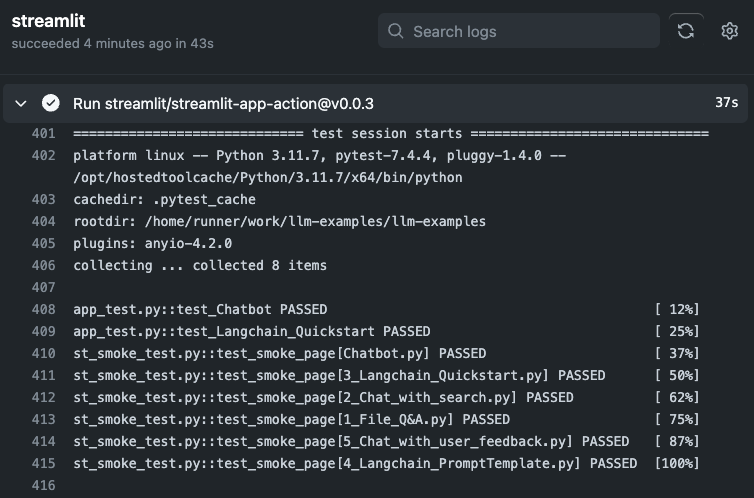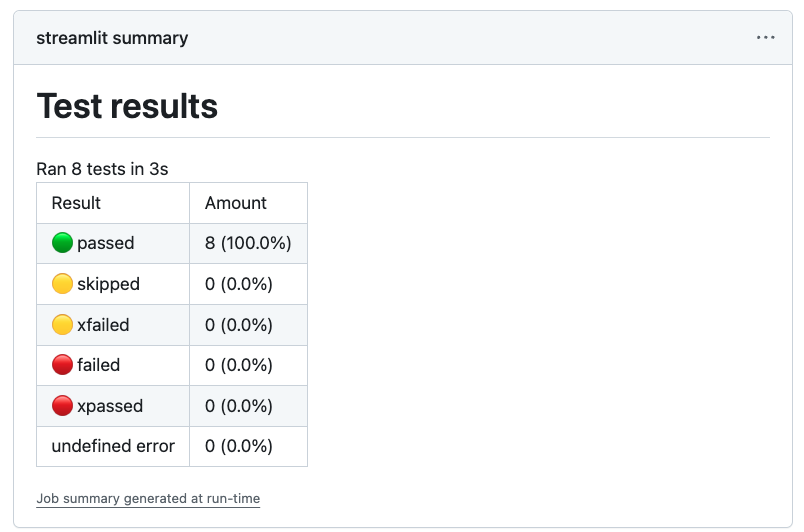Automate your tests with CI
One of the key benefits of app testing is that tests can be automated using Continuous Integration (CI). By running tests automatically during development, you can validate that changes to your app don't break existing functionality. You can verify app code as you commit, catch bugs early, and prevent accidental breaks before deployment.
There are many popular CI tools, including GitHub Actions, Jenkins, GitLab CI, Azure DevOps, and Circle CI. Streamlit app testing will integrate easily with any of them similar to any other Python tests.
GitHub Actions
Since many Streamlit apps (and all Community Cloud apps) are built in GitHub, this page uses examples from GitHub Actions. For more information about GitHub Actions, see:
- Quickstart for GitHub Actions
- GitHub Actions: About continuous integration
- GitHub Actions: Build & test Python
Streamlit App Action
Streamlit App Action provides an easy way to add automated testing to your app repository in GitHub. It also includes basic smoke testing for each page of your app without you writing any test code.
To install Streamlit App Action, add a workflow .yml file to your repository's .github/workflows/ folder. For example:
# .github/workflows/streamlit-app.yml
name: Streamlit app
on:
push:
branches: ["main"]
pull_request:
branches: ["main"]
permissions:
contents: read
jobs:
streamlit:
runs-on: ubuntu-latest
steps:
- uses: actions/checkout@v4
- uses: actions/setup-python@v5
with:
python-version: "3.11"
- uses: streamlit/streamlit-app-action@v0.0.3
with:
app-path: streamlit_app.py
Let's take a look in more detail at what this action workflow is doing.
Triggering the workflow
on:
push:
branches: ["main"]
pull_request:
branches: ["main"]
This workflow will be triggered and execute tests on pull requests targeting the main branch, as well as any new commits pushed to the main branch. Note that it will also execute the tests on subsequent commits to any open pull requests. See GitHub Actions: Triggering a workflow for more information and examples.
Setting up the test environment
jobs:
streamlit:
runs-on: ubuntu-latest
steps:
- uses: actions/checkout@v4
- uses: actions/setup-python@v5
with:
python-version: "3.11"
The workflow has a streamlit job that executes a series of steps. The job runs on a Docker container with the ubuntu-latest image.
actions/checkout@v4checks out the current repository code from GitHub and copies the code to the job environment.actions/setup-python@v5installs Python version 3.11.
Running the app tests
- uses: streamlit/streamlit-app-action@v0.0.3
with:
app-path: streamlit_app.py
Streamlit App Action does the following:
- Install
pytestand install any dependencies specified inrequirements.txt. - Run the built-in app smoke tests.
- Run any other Python tests found in the repository.
Tip
If your app doesn't include requirements.txt in the repository root directory, you will need to add a step to install dependencies with your chosen package manager before running Streamlit App Action.
The built-in smoke tests have the following behavior:
- Run the app specified at
app-pathas an AppTest. - Validate that it completes successfully and does not result in an uncaught exception.
- Do the same for any additional
pages/of the app relative toapp-path.
If you want to run Streamlit App Action without the smoke tests, you can set skip-smoke: true.
Linting your app code
Linting is the automated checking of source code for programmatic and stylistic errors. This is done by using a lint tool (otherwise known as a linter). Linting is important to reduce errors and improve the overall quality of your code, especially for repositories with multiple developers or public repositories.
You can add automated linting with Ruff by passing ruff: true to Streamlit App Action.
- uses: streamlit/streamlit-app-action@v0.0.3
with:
app-path: streamlit_app.py
ruff: true
Tip
You may want to add a pre-commit hook like ruff-pre-commit in your local development environment to fix linting errors before they get to CI.
Viewing results
If tests fail, the CI workflow will fail and you will see the results in GitHub. Console logs are available by clicking into the workflow run as described here.

For higher-level test results, you can use pytest-results-action. You can combine this with Streamlit App Action as follows:
# ... setup as above ...
- uses: streamlit/streamlit-app-action@v0.0.3
with:
app-path: streamlit_app.py
# Add pytest-args to output junit xml
pytest-args: -v --junit-xml=test-results.xml
- if: always()
uses: pmeier/pytest-results-action@v0.6.0
with:
path: test-results.xml
summary: true
display-options: fEX

Writing your own actions
The above is just provided as an example. Streamlit App Action is a quick way to get started. Once you learn the basics of your CI tool of choice, it's easy to build and customize your own automated workflows. This is a great way to improve your overall productivity as a developer and the quality of your apps.
Working example
As a final working example example, take a look at our streamlit/llm-examples Actions, defined in this workflow file.
Still have questions?
Our forums are full of helpful information and Streamlit experts.

